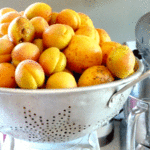You can do lots of things with asian pears to preserve them. Try canning them up into a delicious chutney (there’s a recipe in my book). You could can them in a simple syrup. You could even freeze them to use in tarts or baked goodies this winter. But my favorite way is super simple and easy: dry them.
Maybe it’s because I am so short on time these days chasing a little one. Or perhaps it’s because my little one gobbles up these dried treats. Whatever the reason, dried asian pears have a sugary sweetness that European pears and apples just can’t beat. Drying them seems to lock in that sweetness, making these pear chips an addictive snack.

The process is simple for drying. Core the fruit but leave the skins on (which saves a ton of time). Then slice as thin as you possibly can. After a couple years of making these, I invested in a cheap-o mandolin slicer to get them paper thin. It also makes the slicing go super quick. Just watch your fingers – those slicers are sharp!

Lay the fruit out in a single layer and turn on your dehydrator to about 130-140 degrees for about 8-10 hours. Check them every thirty minutes toward the end of drying to ensure the right consistency. I often dry them overnight, which is insanely convenient. Maybe my next book should be a guide to being a lazy home preservationist…
 You want the end product to be leathery, but not moist. If you over dry them, they might be more like a chip than regular dried fruit. Store them in a glass jar in a cool dry place. They should keep for about a month, although mine have last longer and tasted fine. Enjoy!
You want the end product to be leathery, but not moist. If you over dry them, they might be more like a chip than regular dried fruit. Store them in a glass jar in a cool dry place. They should keep for about a month, although mine have last longer and tasted fine. Enjoy!





 Upgrade your hanging basket game!
Upgrade your hanging basket game!  Here’s
Here’s

 This cluster was about the siz
This cluster was about the siz



 I start with a
I start with a


always interested in food ideas
love food
Can you dry the Asian pears in the oven, too?
Yes, on very low heat – somewhere between 140-180 degrees is probably best.